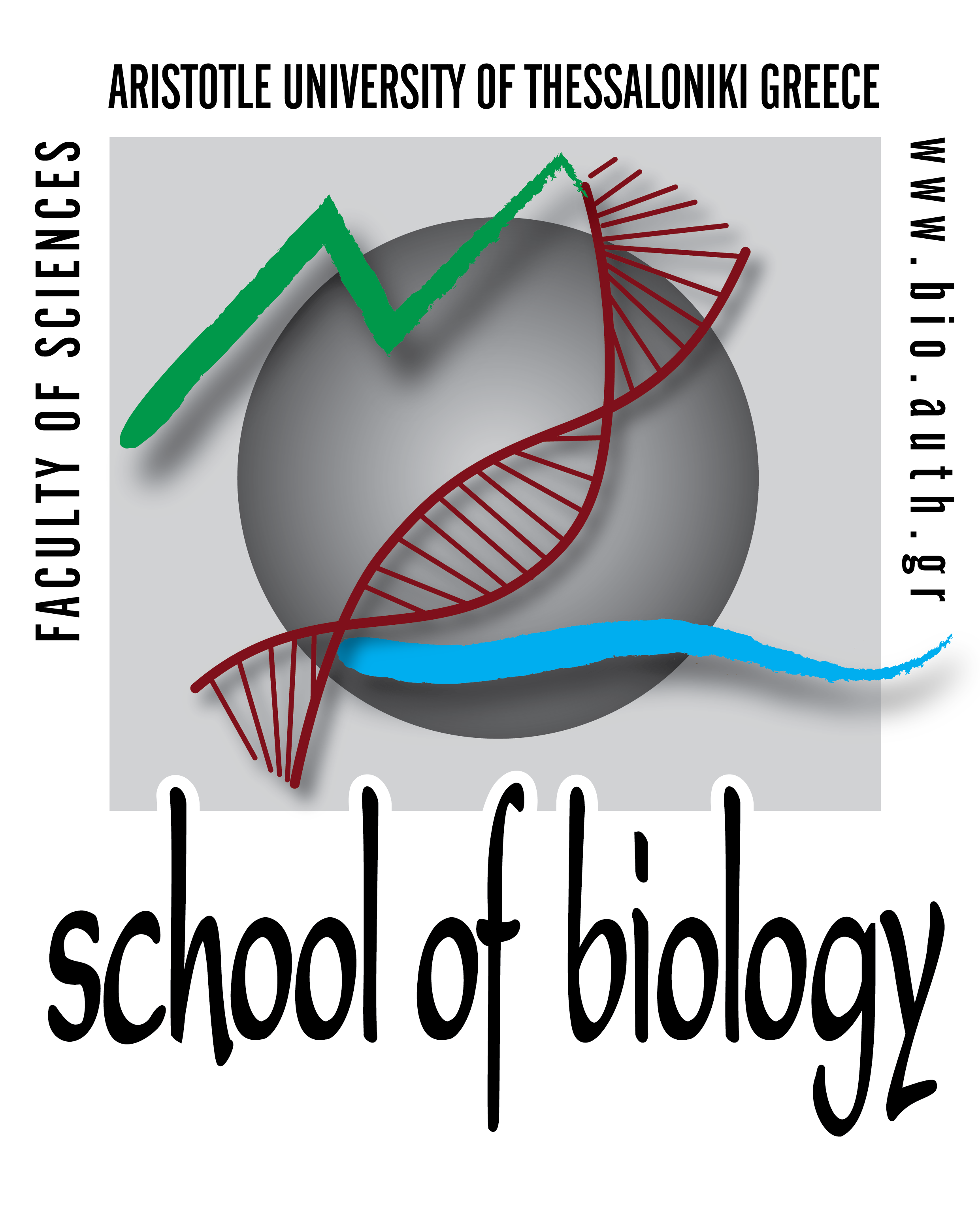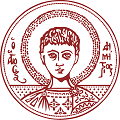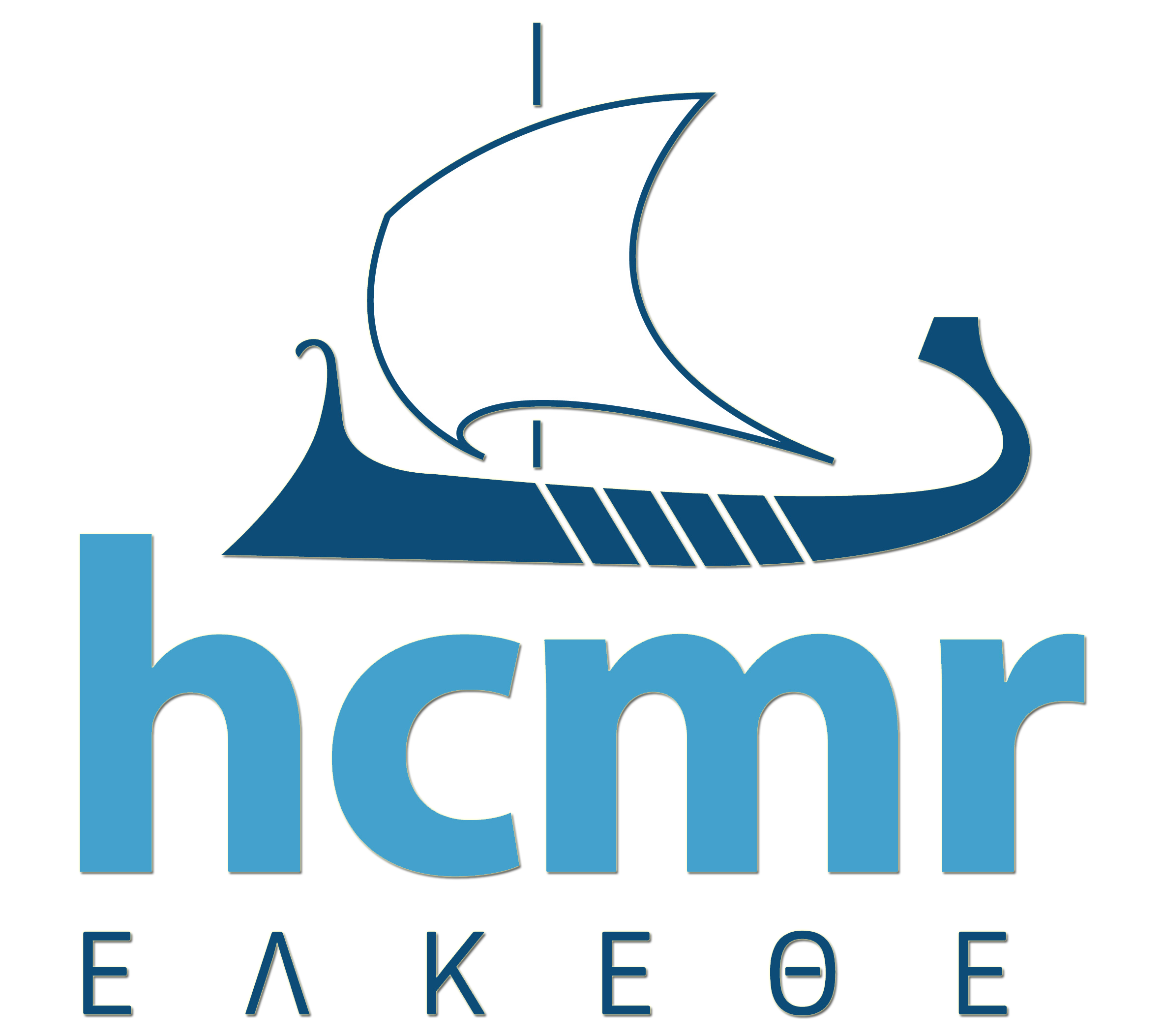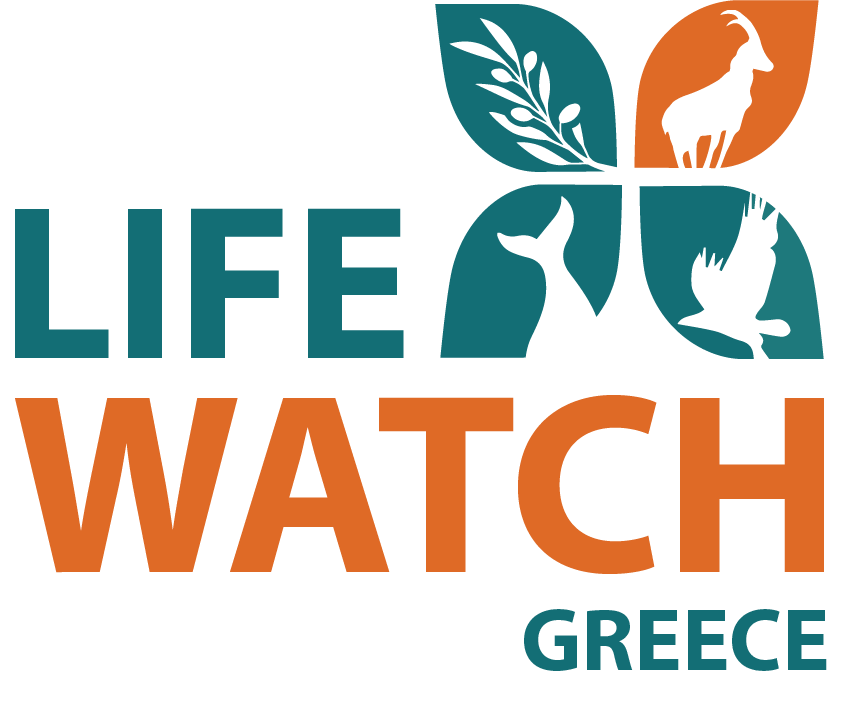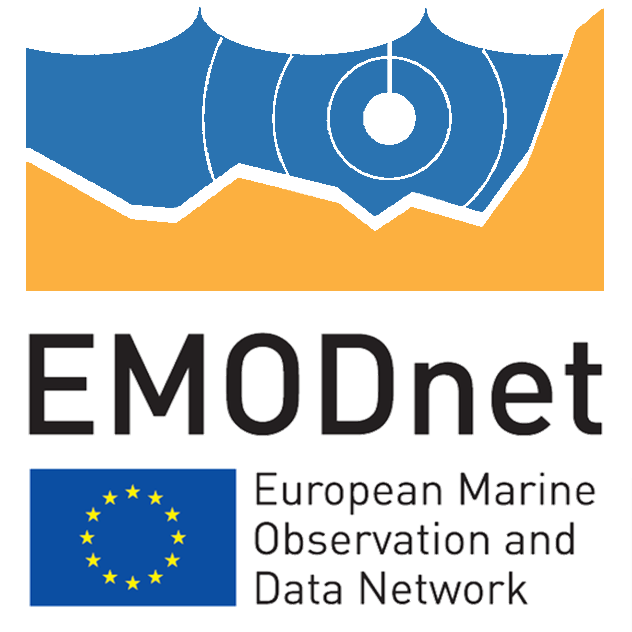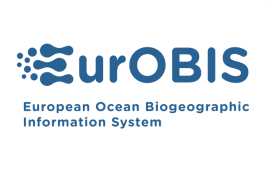The way Aristotle approached the study of what we now know as the science of taxonomy & systematics, looks remarkably familiar to present day biologists. In his attempt to order animal diversity in his work Parts of Animals, he gives an account of the rules to be followed in order to classify animals. Some of his ideas are: i) a simple dichotomous division of animal genē (genera = groups or taxa) should be avoided since it is arbitrary; ii) animal genē should be defined on the basis of multiple characteristics rather than on a single one, iii) animal genē are physical groups that take a certain name (like birds or fish), while other groupings (like terrestrial and aquatic) are anonymous (i.e. those based on non-taxonomic characteristics); iv) animals that differ by analogy are put in different genē (e.g. a bird that has feathers and a fish that has scales), while those that differ by excess and defect or by the more and the less are grouped together (e.g. a bird with short wings and another with long ones).
Although he didn’t intend to construct a thorough classification of animals, he defined several megista genē (major genera – the modern higher taxa). He discriminated anhaima (bloodless animals - the invertebrates) from enhaima (blooded animals - the vertebrates). His marine anhaima comprised three major genera of marine animals: malakia (soft bodied - cuttlefish, squids, octopuses), malakostraca (soft shelled - lobsters, crabs, shrimps, hermit crabs), ostrakoderma (shell skinned - bivalves, gastropods, sea urchins, sea stars, sea squirts), plus several individual animals not classified in major groups (sea anemones, amphipods, isopods, sea cucumbers, jellyfish, etc.). The marine enhaima comprised ichthyes (fish), kētodē (dolphins, whales), the ōotoka tetrapoda (egg laying tetrapods - sea turtles) and zōotoka tetrapoda (live bearing tetrapods - seals).
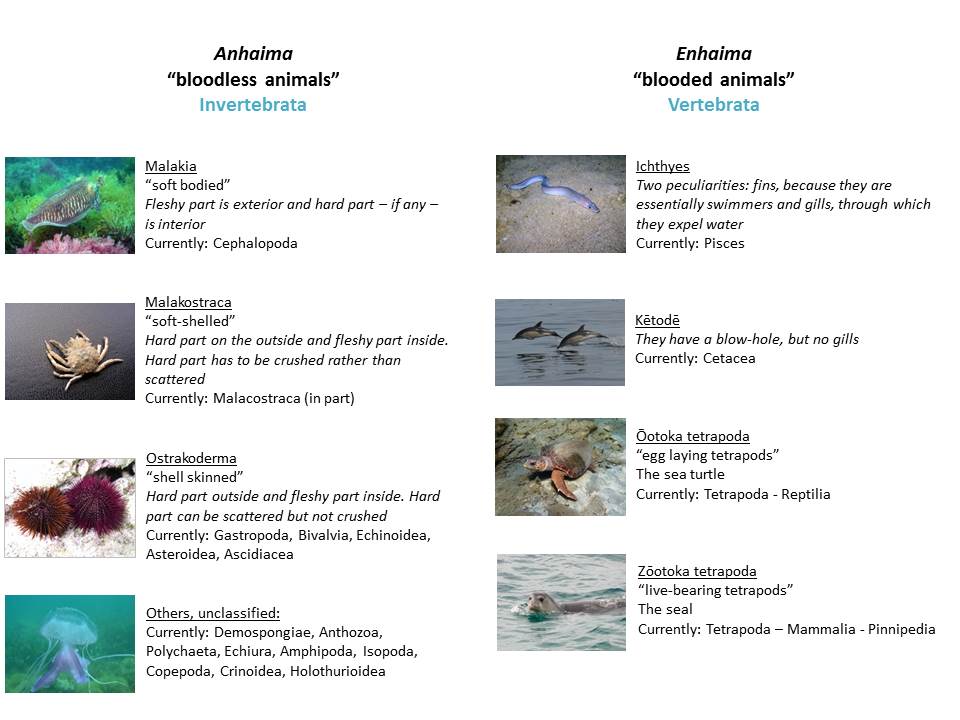
Schematic representation of Aristotle's animal classification. All images are available in WoRMS, under a CC-BY-NC-SA license.
Aristotle’s works were the first written documents on zoology and marine biodiversity. Until the middle of the 16th century, the very few authors (e.g. Pliny the Elder) who wrote on these subjects relied largely on these works. His knowledge of animals passed on to the early modern taxonomists of the 16th-18th centuries, including Linnaeus and Cuvier, through his original writings in Greek or in Latin translations, or through Pliny’s Natural History. Many early taxonomists chose the Greek language to develop scientific terminology in their field of expertise, and Aristotle’s works were a rich source of inspiration for zoological names and terms. And they did not just serve as inspiration… many of the taxonomic names introduced by him are still in use in modern taxonomy and are now available through the World Register of Marine Species (WoRMS), the most authoritative list of names of all marine species globally, ever published. If you want to learn more about Aristotle’s names still in use to today, have a look at one of the next stories: ‘Aristotle and how he contributed to marine animal nomenclature'.
In his zoological works one can find more than 1400 records of marine animal names which, through careful analyses, revealed around 200 taxa of sponges, cnidarians, polychaetes, echiurans, molluscs, crustaceans, echinoderms, ascidians, fishes, marine reptiles, pinnipeds and cetaceans.
| # taxa identified by Aristotle | # taxa identified by Linaeus (#accepted species between brackets) | # species in Greek marine waters | # species in the Mediterranean Sea | |
|---|---|---|---|---|
| Porifera | 6 | 53 (10) | 215 | 681 |
| Cnidaria | 5 | 237 (80) | 86 | 757 |
| Polychaeta | 1 | 132 (50) | 849 | 1122 |
| Echiura | 1 | 0 (0) | 1 | 6 |
| Mollusca | 36 | 1832 (596) | 812 | 2113 |
| Crustacea | 23 | 164 (99) | 813 | 2239 |
| Echinodermata | 9 | 127 (31) | 91 | 154 |
| Ascidiacea | 3 | 25 (5) | 75 | 229 |
| Pisces | 109 | 1150 (292) | 510 | 650 |
| Marine quadrupeds* | 1 | 40 (19) | 16 | 28 |
| TOTAL | 200 | 3760 (1182) | 3468 | 7979 |
Summary table of marine taxa identified from Aristotle’s works (=combination of species and higher ranks), marine taxa identified by Linnaeus (with indication of currently accepted species between brackets), the number of marine (currently accepted) species occurring in the Greek waters and the number of (currently accepted) species occurring in the Mediterranean Sea IHO area according to Coll et al. (2010). Information for the Greek marine waters is based on the preliminary and validated species checklists of the Greek Taxon Information System (GTIS) initiative of the LifeWatchGreece Research Infrastructure (Bailly et al., 2016). *Marine quadrupeds in this context is limited to Cetacea, Pinnipedia & Reptilia.
The extent of Aristotle’s interest in marine animals ranges from simply mentioning them to describing in detail their morphology and anatomy. Several times throughout his extant works he refers to his Anatomai (the Anatomies - a separate book thought to contain his drawings, which is not extant) for better understanding of his descriptions. Nowadays, taxonomists still make drawings of newly discovered taxa as part of the description, but access to them is now much easier than it was thanks to the many advances being made in the digital era. Many musea are now offering micro-computed tomography (microCT) scans of animals to scientists in addition to more standard photographs of specimens. MicroCT scans are highly detailed stacks of x-ray images of specimens which can be transformed to three-dimensional (3D) interactive models with a resolution down to the micrometer scale or even below. These ‘digitised specimens’ are being made accessible through web-based frameworks - for example through the MicroCT vLab of LifeWatch Greece - , so that users can manipulate and study them. This way, digital versions of specimen collections, or “cybertypes” when it comes to the original type material, can be compiled, greatly improving access to museum collections globally. The Virtual Museum of Natural History (VMNH) is a first example of the potential integration of this technology to our current practices applied in musea and collections.
Characteristic examples of species with particular interest for Aristotle are all well-known and exploited species of the Mediterranean: i) the cephalopods: he describes and compares the sēpia (cuttlefish), polypous (octopuses), teuthos and teuthis (squids) and goes even further by distinguishing the anatomy of males and females; ii) the macrura reptantia (astakos = Hommarus gammarus and karabos = Palinurus elephas) which he also describes in a comparative manner; iii) the bath sponges (he describes their nature and morphology and mentions the four species harvested in the Mediterranean); iv) the common sea urchin (he describes its general body structure and anatomy).
Thus, the foundations of taxonomy – as laid down by Aristotle – are still in use today… Certainly, if we see Aristotle’s classification from the perspective of modern taxonomy we will find some “errors”. For example he classified i) ascidians and echinoids in ostracoderma along with bivalves and gastropods, using the hard body cover as a common characteristic; ii) the angler fish in the selachia with the rays and skates probably because of its flattened body form, although he knew that it was oviparous and had a bony skeleton. When we take into account the huge challenges Aristotle must have faced when performing this pioneering work in marine taxonomy more than two millennia ago, one can only admire the man!
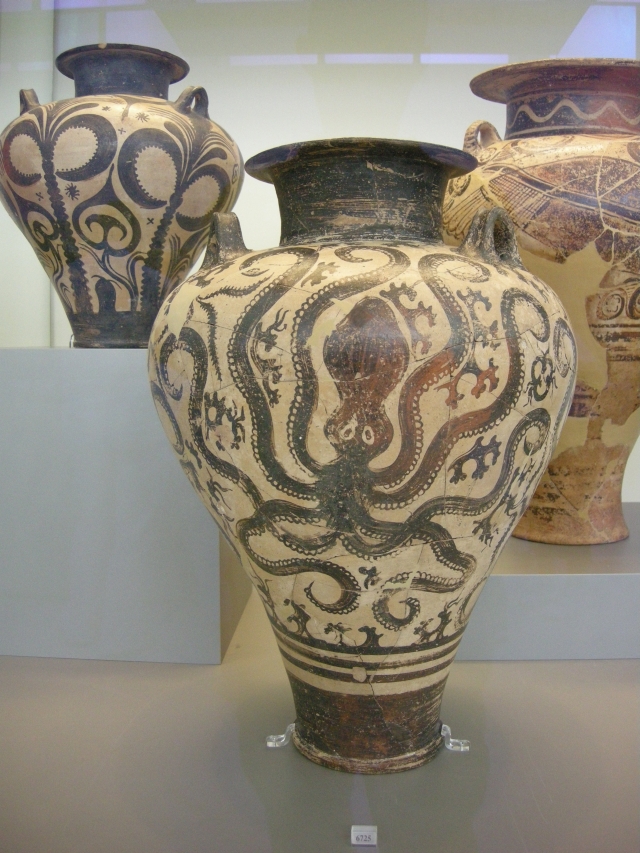 | 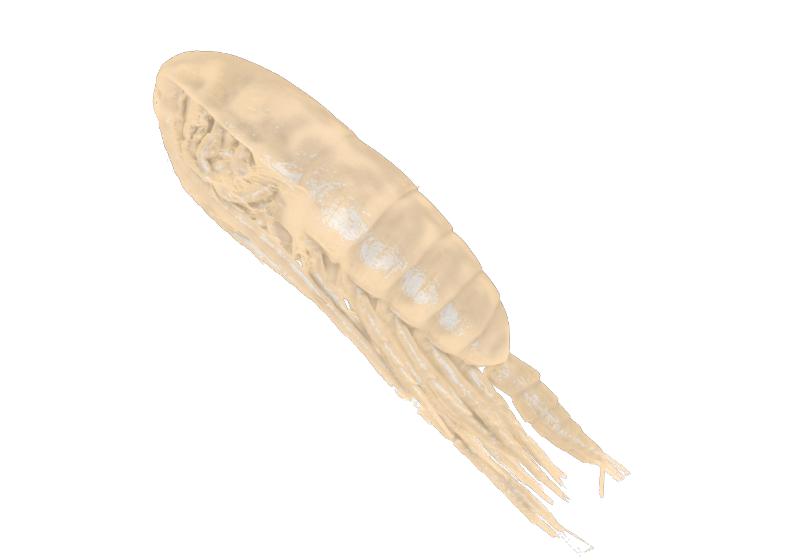 |
An octopus depicted on Mycenic Greek pottery dating from 1500 BC (far before the era of Aristotle) present in the National Archeological Museum in Athens, Greece. Photo: Sailco / Wiki Commons. | Micro-CT was performed on a copepod belonging to the genus Calanus. Image from MicroCT vLab, LifeWatchGreece (CC-BY-NC-SA). |
References:
- Antoniadou, C.; Gerovasileiou, V.; Bailly, N. (2016). Ascidiacea (Chordata: Tunicata) of Greece: an updated checklist. Biodiversity Data Journal, 4: e9273
- Arvanitidis, C.; Chatzinikolaou, E.; Gerovasileiou, V.; Panteri, E.; Bailly, N.; Minadakis, N.; Hardisty, A.;, Los, W. (2016). LifeWatchGreece: Construction and operation of the National Research Infrastructure (ESFRI). Biodiversity Data Journal, 4: e10791
- Bailly, N.; Gerovasileiou, V.; Arvanitidis, C.; Legakis, A. (2016). Introduction to the Greek Taxon Information System (GTIS) in LifeWatchGreece: the construction of the Preliminary Checklists of Species of Greece. Biodiversity Data Journal, 4: e7959
- Coll, M.; Piroddi, C.; Steenbeek, J.; Kaschner, K.; Ben Rais Lasram, F.; Aguzzi, J.; Ballesteros, E.; Bianchi, C.N.; Corbera, J.; Dailianis, T.; Danovaro, R.; Estrada, M.; Froglia, C.; Galil, B.S.; Gasol, J.M.; Gertwagen, R.; Gil, J.; Guilhaumon, F.; Kesner-Reyes, K.; Kitsos, M.-S.; Koukouras, A.; Lampadariou, N.; Laxamana, E.; López-Fé de la Cuadra, C.M.; Lotze, H.K.; Martin, D.; Mouillot, D.; Oro, D.; Raicevich, S.; Rius-Barile, J.; Saiz-Salinas, J.I.; San Vicente, C.; Somot, S.; Templado, J.; Turon, X.; Vafidis, D.; Villanueva, R.; Voultsiadou, E. (2010). The biodiversity of the Mediterranean sea: estimates, patterns, and threats. PLoS One 5(8): e11842
- Cuvier, G.; Valenciennes, A. (1828). Histoire naturelle des poisons. Vol 1. F.G. Levrault, Paris.
- Ganias, K.; Mezarli, C.; Voultsiadou, E. (submitted). Aristotle as an ichthyologist. Aegean fish diversity 2400 years ago.
- Gerovasileiou, V.; Bailly, N. (2016). Brachiopoda of Greece: an annotated checklist. Biodiversity Data Journal, 4: e8169
- Gerovasileiou. V.; Rosso, A. (2016). Marine Bryozoa of Greece: an annotated checklist. Biodiversity Data Journal, 4: e10672
- Gkelis, S.; Ourailidis, I.; Panou, M.; Pappas; N. (2016). Cyanobacteria of Greece: an annotated checklist. Biodiversity Data Journal, 4: e10084
- Koulouri, P.; Gerovasileiou, V.; Bailly, N. (2016). Mysida and Lophogastrida of Greece: a preliminary checklist. Biodiversity Data Journal, 4: e9288
- Koulouri, P.; Gerovasileiou, V.; Bailly, N. (2016). Cumacea of Greece: a preliminary checklist. Biodiversity Data Journal, 4: e9287
- Leroi, A.M. (2014). The Lagoon: How Aristotle Invented Science. Bloomsbury Publishing, London.
- Linnaeus, C. (1758). Systema Naturae per regna tria naturae, secundum classes, ordines, genera, species, cum characteribus, differentiis, synonymis, locis. Tomus I. Editio decima, reformata. Laurentius Salvius: Holmiae. II, 824 pp.
- Linnaeus, C. (1759). Systema Naturae per regna tria naturae, secundum classes, ordines, genera, species, cum characteribus, differentiis, synonymis, locis. Tomus II. Editio decima, reformata. Laurentius Salvius: Holmiae. 825-1384 pp.
- Voultsiadou, E. (2007). Sponges: an historical survey of their knowledge in Greek antiquity. Journal of the Marine Biological Association UK 87: 1757-1763.
- Voultsiadou, E., Gerovasileiou, V.; Bailly, N. (2016). Porifera of Greece: an updated checklist. Biodiversity Data Journal, 4: e7984
- Voultsiadou, E.; Vafidis, D. (2007). Marine invertebrate diversity in Aristotle’s zoology. Contributions to Zoology 76, 103-120.
Images in Figure (all under CC-BY-NC-SA and available through WoRMS):
- Sepia officinalis (cuttlefish): [species page] - [image]
- Maja squinado (Mediterranean spider crab): [species page] - [image]
- Paracentrotus lividus (stony sea urchin): [species page] - [image]
- Pelagia noctiluca (purplestripped jelly): [species page] - [image]
- Conger conger (European conger): [species page] - [image]
- Delphinus delphis (long-beaked saddle-back dolphin): [species page] - [image]
- Caretta caretta (loggerhead turtle): [species page] - [image]
- Monachus monachus (monk seal): [species page] - [image]
